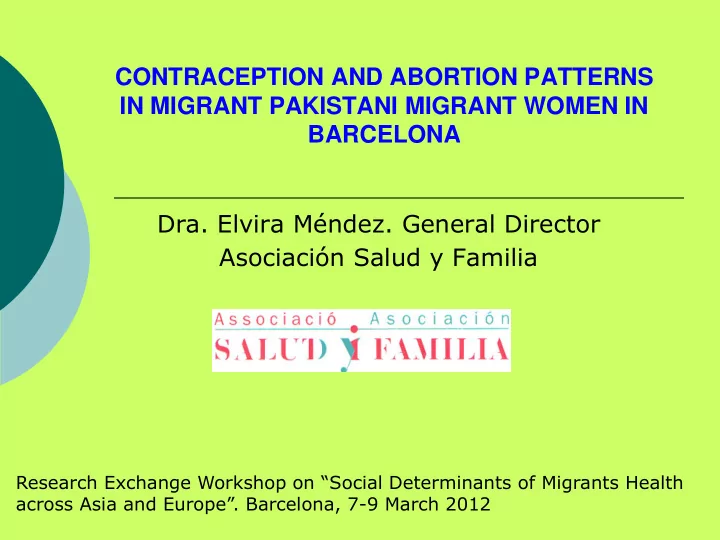

CONTRACEPTION AND ABORTION PATTERNS IN MIGRANT PAKISTANI MIGRANT WOMEN IN BARCELONA Dra. Elvira Méndez. General Director Asociación Salud y Familia Research Exchange Workshop on “Social Determinants of Migrants Health across Asia and Europe”. Barcelona, 7 -9 March 2012
Descriptive study on a population (2008-2011) of 190 Pakistani women users of the Programs “ Care for mothers at risk ” and “ Mothers between two cultures ” of the Health and Family Association. 2
THE PAKISTANI COMMUNITY IN BARCELONA 3
THE PAKISTANI COMMUNITY IN BARCELONA (I) Men Women Total Ratio Men / Women 2011 18.521 3.542 22.063 5,2% 2010 15.702 2.204 17.906 7,1% 2009 15.118 1.946 17.064 7,7% 2008 13.424 1.698 15.122 7,9% Source: INE 4
THE PAKISTANI COMMUNITY IN BARCELONA (II) Yearly Pakistani Foreigners Total Increase people on on total population Pakistani foreign population population population 2011 23,2% 6,4% 21,1% 1.615.448 2010 4,9% 5,3% 20,9% 1.619.337 2009 12,8% 5,1% 20,7% 1.621.537 2008 __ 4,7% 19,7% 1.615.908 5 Source: INE
SOCIODEMOGRAPHIC PROFILE OF PAKISTANI WOMEN USERS (I) Pakistani women residents in Barcelona from the Punjab region, areas of Gujrat and Gujranwala. Legal migrants women by way of family reunification. Women in reproductive age (19-45 years) being the most frequent age group of 25-31 years. Most live in the neighborhood of Ciutat Vella (Barcelona). Source: Programme “Care for mothers at risk”. Asociación Salud y Familia 6
SOCIODEMOGRAPHIC PROFILE OF PAKISTANI WOMEN USERS (II) 89% of Pakistani women users are married. 15,8% of Pakistani women users are illiterate. 49% of Pakistani women users up to them reach primary school. 83,3% of Pakistani women users are housewives. 58% of Pakistani women users don’t understand Spanish. Source: Programme “Care for mothers at risk”. Asociación Salud y Familia 7
FECUNDITY AND HEALTH REPRODUCTIVE PROFILE OF PAKISTANI WOMEN USERS 57,8% of Pakistani women users have more two children being the most frequent families with three-four children. 68,4% of Pakistani women did not use any contraceptive method. 23,5% of couples used the male condom as a contraceptive method to space births. 89,3% of Pakistani women did not use contraceptive care during the last year. Source: Programme “Care for mothers at risk”. Asociación Salud y Familia 8
HEALTH REPRODUCTIVE PROFILE OF PAKISTANI WOMEN USERS 149 Pakistani women sought help for pregnancy termination being 0,65% of total vulnerable women. 94% of Pakistani women had a pregnancy of less than 12 weeks of gestation. 30,9% of Pakistani women had previous abortions. Source: Programme “Care for mothers at risk”. Asociación Salud y Familia 9
PAKISTANI WOMEN USERS AND LONG LASTING CONTRACEPTION Intrauterine device (DIU) is the best contraceptive method for prevention of repeated abortions in fertile women (Cohrane Foundation & WHO recommendations). 35,6% of Pakistani women accepted DIU counselling. 18,1% of Pakistani women implanted DIU. 10
COMPARISONS PROFILE OF PAKISTANI WOMEN RELATING TO VULNERABLE WOMEN USERS (2008-2011) 11
COMPARISON OF SOCIODEMOGRAPHIC PROFILE OF PAKISTANI WOMEN RELATING TO VULNERABLE WOMEN USERS (2008-2011) Pakistani Vulnerable Women Women 89% Civil Status 21,3% married Illiteracy 15,8% 2,1% 49% Until Primary 30,5% School 83,3% Housewives 50% Source: Programme “Care for mothers at risk”. Asociación Salud y Familia 12
COMPARISON OF FECUNDITY AND HEALTH REPRODUCTIVE PROFILE OF PAKISTANI WOMEN RELATING TO VULNERABLE WOMEN USERS (2008-2011) Pakistani Vulnerable Women Women 57,8% More than two 14,4% children 68,4% No method of 44,1% contraception No contraception = 89,3% 82,6% care during the last year Source: Programme “Care for mothers at risk”. Asociación Salud y Familia 13
COMPARISON OF HEALTH REPRODUCTIVE PROFILE OF PAKISTANI WOMEN RELATING TO VULNERABLE WOMEN USERS (2008-2011) Pakistani Vulnerable Women Women Seeking 149 (0,65%) 23.034 termination of pregnancy Less 12 weeks 94% 86,4% of gestation Previous 30,9% 44,6% abortions Source: Programme “Care for mothers at risk”. Asociación Salud y Familia 14
COMPARISON OF LONG LASTING CONTRACEPTION IN PAKISTANI WOMEN RELATING TO VULNERABLE WOMEN USERS (2008-2011) Pakistani Vulnerable Women Women DIU acceptation = 35,6% 36,1% DIU implantation = 18,1% 20,2% Source: Programme “Care for mothers at risk”. Asociación Salud y Familia 15
CONCLUSIONS 16
CONCLUSIONS (I) Pakistani women users have a share capital (educational levels and employment status) lower than population of vulnerable women. Pakistani women users and her families have a pattern of medium- high fecundity and a clear preference for more children than population of vulnerable women. 17
CONCLUSIONS (II) The use of contraceptive methods is aimed at the spacing of births and couples often choose male- controlled methods (male condom). Abortion is used as a control strategy of fertility in the context of marriage when a new child is a burden at any give time. 18
CONCLUSIONS (III) Pakistani women use long lasting contraceptive methods, even after the abortion, at a rate similar total of vulnerable women. Pakistani women use the services available to contraceptive advice at a very low proportion like that of vulnerable women. 19
CONCLUSIONS (IV) Health reproductive seeking behaviors of Pakistani women are strongly influenced by the cultural standards of their community and to a lesser extent by the legal accessibility to health services. 20
CONCLUSIONS (V) In Spain, legal migrants have full rights and total accessibility to public health services. In this context lack of understanding in Spanish after several years of stay is a barrier for developing more autonomous and healthy behaviors. 21
BROCHURES PUBLISHED IN URDÚ 22
23
24
25
THANK YOU Elvira Méndez Special thanks to Fariza Habib. Intercultural mediator with Pakistani community
Recommend
More recommend